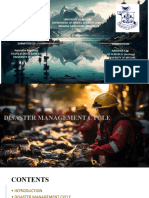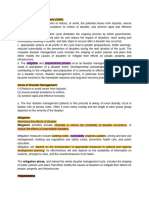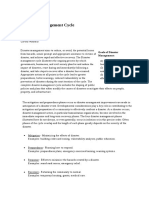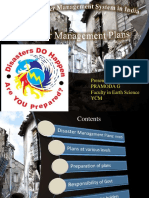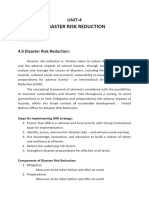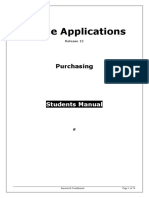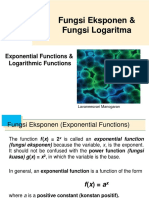Disaster Management Unit 3
Disaster Management Unit 3
Uploaded by
Kkm KalariyaCopyright:
Available Formats
Disaster Management Unit 3
Disaster Management Unit 3
Uploaded by
Kkm KalariyaCopyright
Available Formats
Share this document
Did you find this document useful?
Is this content inappropriate?
Copyright:
Available Formats
Disaster Management Unit 3
Disaster Management Unit 3
Uploaded by
Kkm KalariyaCopyright:
Available Formats
3.
Disaster Management Cycle and Framework
3.1. Disaster Management Cycle
Emergency management activities can be grouped into five phases that are related by
time and function to all types of emergencies and disasters.
These phases are also related to each other, and each involves different types of skills.
Figure 1 Phases of Disaster Management
Planning
Activities necessary to analyze and document the possibility of an emergency or disaster
and the potential consequences or impacts on life, property, and the environment.
This includes assessing the hazards, risks, mitigation, preparedness, response, and
recovery needs.
Mitigation
Activities that actually eliminate or reduce the probability of a disaster.
It also includes long-term activities designed to reduce the effects of unavoidable disaster
(e.g. land use management, building restrictions in potential flood zones).
Preparedness
Activities necessary to the extent that mitigation measures have nit, or cannot, prevent
disasters.
In the preparedness phase, governments, organizations, and individuals develop plans to
save lives and minimize disaster damage.
Preparedness measures also seek to enhance disaster response operations (e.g.
compiling state resource inventories, mounting training exercises, installing early
warning systems etc.).
Response
Search and rescue – Activities following an emergency or disaster.
These activities are designed to provide emergency assistance for victims.
Prof. B. D. Kanani, EE Department Disaster Management (3150913) 1
3. Disaster Management Cycle and Framework
Search and rescue operations are carried out to save the lives of the people which is the
highest priority.
They also seek to stabilize the situation and reduce the probability of secondary damage
and to speed recovery operations (e.g. damage assessment).
Recovery
Activities necessary to return all systems to normal or better. They include two sets of
activities:
(1) Short-term recovery activities return vital life-support systems to minimum operating
standards (e.g. cleanup, temporary housing, and access to food and water).
(2) Long-term recovery activities may continue for a number of years after disaster. Their
purpose is to return life to normal or improved levels (e.g. redevelopment loans, legal
assistance, and community planning).
3.2. Paradigm Shift in Disaster Management
The meaning of paradigm shift is “a fundamental change in approach or underlying
assumptions”.
For paradigm shift, the disaster management authority should know
Weather or not an emergency exists
The demographics of the affected population and the number of people affected
The details of the emergency (cause, location, magnitude of disaster etc.)
The condition of the affected population (mortality and morbidity rates)
The local response capacities and available resources, including organizational
and logistical capabilities
The extent and type of life-saving needs and priorities
The likelihood of additional future problems or needs
The starting point for any assessment is identification of the eventual users of the
information and their particular information needs.
Data, which include perceptions, numbers and facts, only become useful information
when they are meaningful, and relevant at particular times and places, for specific
purposes.
Pre-Disaster Preparedness
All phases of emergency management depend on data from a variety of sources.
The appropriate data has to be gathered, organized, and displayed logically to determine
the size and scope of emergency management programs.
During an actual emergency it is critical to have the right data, at the right time, to respond
and take appropriate action.
Emergencies can impact all or a number of government departments.
Emergency personnel often need detailed information concerning pipelines, building
layout, electrical distribution, sewer systems, and so forth.
Prof. B. D. Kanani, EE Department Disaster Management (3150913) 2
3. Disaster Management Cycle and Framework
3.3. Disaster Risk Assessment
Some general risks frequently present in the emergency phase are:
Continuing presence of hazard agents – secondary flooding, fire, landslides,
extreme cold, chemical pollution etc.
Loss of lifeline services – clean water, waste disposal, medical treatment
Inadequate supply of emergency clinical services
Inadequate supply of essential foods
Effects of severe climate conditions exacerbated by lack of shelter, warm clothing
or heating fuel
Tools for conducting disaster risk assessment
A national risk assessment is a strategic risk assessment that supports the design
of National Disaster management strategies, policy and regulations, NDM
programming, and budget allocation.
A local risk assessment is an operational risk assessment for NDM action planning,
contingency planning, pre-disaster recovery planning, and proper urban planning
to conduct risk assessment in pilot regions.
Build national disaster observatories (NDO). A NDO is a sustainable local
institution helps the countries to learn from their disaster history and incorporate
that knowledge into the national NDM strategy and the implementation of disaster
risk management activities.
3.4. Disaster Risk Mapping
Risk mapping is the process of establishing the spatial and temporal extent of risk
(probability and consequences).
The results of risk mapping are usually presented in the form of maps that show the
magnitude and nature of the risk.
Risk mapping requires combining maps of hazards, exposure, and vulnerability.
The average frequency of occurrence and location of most extreme events can be
determined with some degree of accuracy. While global maps of hazards, such as
potential desertification, severe storms, and earthquake and volcanic activity, do exist, a
more detailed approach is of more use to environmental health and disaster planners.
Maps of the zones surrounding hazardous factories and the routes used to transport
hazardous materials, plus data on seasonal wind velocity and direction, can be used to
predict the scale of possible hazards and determine the method of evacuation or other
emergency response if leaks or explosions occur.
3.5. Relief and Rehabilitation Approach
Relief is no longer perceived only as gratuitous assistance or provision of emergency
relief supplies on time.
It is on the contrary, viewed as an overarching system of facilitation of assistance to the
victim of disaster for their rehabilitation in states and ensuring social safety and security
of the affected persons.
The relief needs to be prompt, adequate and of approved standards.
Prof. B. D. Kanani, EE Department Disaster Management (3150913) 3
3. Disaster Management Cycle and Framework
Guidelines defining minimum standards of relief will be prepared by the NDMA. Setting
up of temporary relief camps.
DDMAs, especially in recurring disaster prone areas, may identify locations for setting up
temporary camps.
The temporary relief camps will have adequate provision of drinking water and bathing,
sanitation and essential health-care facilities.
Ensuring minimum standards of relief and speedy management of supplies are
important.
3.6. Reconstruction and Redevelopment Approach
Owner Driven Reconstruction
Reconstruction plans and designing of houses need to be a participatory process
involving the government, affected community, NGOs and corporate sector.
Reconstruction program will be within the confines and the qualitative
specifications laid down by the government.
Speedy Reconstruction
Essential services, social infrastructure and intermediate shelters/camps will be
established in the shortest possible time.
Contingency plans for reconstruction
In highly disaster prone areas need to be drawn out during the period of normalcy,
which may include architectural and structural designs in consultation with the
various stakeholders.
Linking recovery with safe development
Efforts will be made to support and enhance the viability of the livelihood systems,
education, health-care facilities, care of the elderly, women and children etc.
Livelihood Restoration
State government will have to lay emphasis on the restoration of permanent
livelihood of those affected by disasters and special attention to the needs of
women-headed households, artisans, farmers and people belonging to
marginalized and vulnerable sections.
3.7. Capacity Development Approach
A strategic approach to capacity development can be addressed effectively only with the
active and enthusiastic participation of the stakeholders.
This process comprises awareness generation, education, training, R&D etc.
It further address putting in place appropriate institutional framework, management
systems and allocation of resources for efficient prevention and handling of disasters.
Identification of knowledge-based institutions with proven performance.
Promotion of international and regional cooperation.
Capacity analysis of different disaster response groups at state/district/local levels.
Adoption of traditional and global best practices and technologies.
Laying emphasis on table-top exercises, simulations, mock drills and development of
skills to test the plans.
Prof. B. D. Kanani, EE Department Disaster Management (3150913) 4
3. Disaster Management Cycle and Framework
3.8. Search and Rescue of Disaster Survivors
Disaster Mitigation requires rapid and efficient search and rescue of survivors.
The goal of search and rescue is to locate and access injured or trapped victims, stabilize
the emergency situation, and transport the patients to safety.
Relief workers need to speedily find the trapped survivors in collapsed buildings and
crumbled structures in the aftermath of disasters.
Newer and advanced technologies and equipment have recently made in search and
rescue operations, making them easier and quicker, while improving a missing or injured
person’s chance of survival.
Technology Options:
The choice of search and rescue tools and methods depends on their availability and the
needs of the situation.
For example, storm and earthquakes wreckage may require tools for lifting debris
whereas flood damage may require boats and ropes.
Different scenarios require differing technology options for disaster search and rescue.
These are summarized below:
Improved real time data access
The ability to communicate
Lighter, more efficient power sources
Improved monitoring systems
Improved personal protective equipment
Improved debris removal systems etc.
Search and Rescue of Disaster Survivors
Tools and Equipment:
The tools and equipment for disaster search and rescue operations include cutting
equipment, diving equipment, forcible entry tools, jacks, life rafts, lighting torch, lamps,
searchlights, location beacons, night vision equipment, pneumatic/hydraulic equipment
and tools, rescue equipment, rescue tools, rope rescue systems, rescue belts, safety
equipment, search equipment, spreading tools, thermal imaging equipment, water rescue
equipment, winches, robotic systems, etc.
High-tech Tool for Disaster Rescue:
Scientists have provided risk communication models and insight into how humans
percieve and react to risk communication.
Another tool being developed by RESCUE researchers is a complex disaster simulation
platform called MetaSim. This computer system allows researchers to merge different
types of simulations at once in order to provide planners with a more accurate picture of
what conditions may like during and after a disaster.
3.9. Early Warning System
Early warning systems are combinations of tools and processes embedded within
institutional structures, coordinated by international and sometimes national agencies.
Prof. B. D. Kanani, EE Department Disaster Management (3150913) 5
3. Disaster Management Cycle and Framework
Whether they focus on one particular hazard or many, these systems are composed of
four elements:
Knowledge of risk
A technical monitoring and warning service
Dissemination of meaningful warnings to at risk people and
Public awareness and preparedness to act.
3.10. Technology for monitoring and warning
Forecasting and modelling technology
Several countries have early warning systems based on seasonal to interannual climate
forecasts. These systems are based on using monitoring data, including temperature and
rainfall values, and state of the art climate models.
Remote sensing and geographic information systems (GIS) applications
Remote sensing and GIS applications have significantly advanced famine early warning
systems.
The Regional Centre for Mapping of Resources for Development (RCMRD) has been using
remote sensing based regional early warning systems for food security to supplement
national initiatives in eastern African countries.
Satellite communication technology
Improvements in satellite communication have helped decrease the lag time between
data collection and warning.
For example, the pacific tsunami warning system works by a recorder on the seabed
relaying data on anomalies to a buoy on the surface. This data is then transmitted via
satellite to ground stations every 15 seconds. In India, it is done by ISRO.
Mobile phone technology
This technology is now increasingly used to communicate warnings and coordinate
preparation activities, particularly SMS alerts for disseminating mass messages.
For example, upon detection of p-waves that precede earthquakes shaking, Japanese
agencies send out SMS alerts to all registered mobile phones in the country.
ICTs for crowd sourcing
The use of crowd sourced data is gaining traction with increasing internet connectivity
and use of information and communication technologies such as mobile phones.
Crowd sourcing was used extensively in the response to the 2010 Haiti earthquakes,
allowing local people, mapping experts and other stakeholders to communicate what they
saw and heard on the ground, and to produce information that could be used by
humanitarian workers. This was particularly useful in locating survivors who needed
assistance.
Crisis mapping
Through initiatives such as Ushahidi and Google Crisis Response, crisis mapping utilizes
crowd sourcing as well as satellite imagery, participatory maps and statistical models to
power more informed and effective early warning.
It can provide real time information on an upcoming crisis in times of uncertainty and
confusion.
Prof. B. D. Kanani, EE Department Disaster Management (3150913) 6
3. Disaster Management Cycle and Framework
3.11. IDNDR (International Decade for National Disaster Reduction)
The United Nations General Assembly designated the 1990s as the International Decade
for Natural Disaster Reduction (IDNDR).
Its basic objective was to decrease the loss of life, property destruction and social and
economic disruption caused by natural disasters, such as earthquakes, tsunamis, floods,
landslides, volcanic eruption, droughts, and other disasters of natural origin.
What is needed for the success of IDNDR?
A large degree on the positive responses of outside agencies, engineers and scientists of
all professions.
Groups of people who are really devoted to take actions are needed.
Team spirit among all nations, among engineers and scientists of different professions,
and among all kinds of people working for disaster mitigation.
Technological Up gradation
To share good practices and lessons learned to further disaster reduction within the
context of attaining sustainable development, and to identify gaps and challenges.
To increase awareness of the importance of disaster reduction policies.
Public awareness and education, community participation.
To increase the reliability and availability of appropriate disaster-related information to
the public and disaster management agencies in all regions.
3.12. Yokohama Strategy
Strategy and plan of action – Introduction
The World Conference on Natural Disaster Reduction, having met at Yokohama from 23
to 27 May 1994, recognizing the rapidly rising world-wide toll on human and economic
losses due to natural disasters.
Basis for Strategy
Natural disasters continue to strike and increase in magnitude, complexity, frequency and
economic impact.
In this context the least developed countries, small island developing states and land-
locked countries are the most vulnerable countries.
In all countries the poor and socially disadvantaged groups suffer most from natural
disasters and are least equipped to cope with them.
Some patterns of consumption, production and development have the potential for
increasing the vulnerability to natural disasters.
Strategy for the Year 2000 and beyond
The world conference, based on adoption of the principles and the assessment of the
progress accomplished during the first half of the Decade, has formulated a strategy for
disaster reduction centered on the objective of saving human lives and protecting
property.
The strategy calls for an accelerated implementation of a Plan of Action to be developed
from the following points:
Development of a global culture of prevention as an essential component of an
integrated approach to disaster reduction.
Prof. B. D. Kanani, EE Department Disaster Management (3150913) 7
3. Disaster Management Cycle and Framework
Adoption of a policy of self-reliance in each vulnerable country and community.
Education and training in disaster prevention, preparedness and mitigation.
Improvement of awareness in vulnerable communities.
Involvement and active participation of people in disaster reduction, prevention
and preparedness, leading to improved risk management.
Improved risk assessment, broader monitoring and communication of forecasts
and warnings.
3.13. Hyogo Framework
In January 2005, 168 Governments adopted a 10-year plan to make the world safer from
natural hazards at the World Conference on disaster reduction, held in Kobe, Hyogo,
Japan.
The Hyogo Framework is a global blueprint for disaster risk reduction efforts during the
next decade. Its goal is to substantially reduce disaster losses by 2015 in lives, and in the
social, economic, and environmental assets of communities and countries.
The Hyogo Framework offers guiding principles, priorities for action, and practical means
for achieving disaster resilience for vulnerable communities.
The five priority actions identified by the Hyogo Framework Action (HFA) are to:
Ensure DRR is a national and a local priority.
Identify, assess and monitor disaster risk and enhance early warning.
Use knowledge, innovation and education to build a culture of safety and resilience
at all levels.
Reduce underlying risk factors.
Strengthen disaster preparedness for effective response at all levels.
The Hyogo Framework Action also identifies four priority cross-cutting areas for
reducing disaster risk: gender, capacity development, communities and
volunteers, and climate change adaption.
-------
Prof. B. D. Kanani, EE Department Disaster Management (3150913) 8
You might also like
- High Yield NBME Images AnnotatedDocument84 pagesHigh Yield NBME Images AnnotatedNareman Abd El HadeNo ratings yet
- Guide To PrescribingDocument68 pagesGuide To PrescribingPetrea Cosmin50% (2)
- Disaster ManagementDocument33 pagesDisaster ManagementNeha Mittal50% (2)
- Disaster Management Cycle by Abhishek C NDocument33 pagesDisaster Management Cycle by Abhishek C Nabhishek7353abhiNo ratings yet
- Skills Disaster FinalsDocument5 pagesSkills Disaster Finalsmendozajanice0601No ratings yet
- Disaster ManagementDocument9 pagesDisaster Managementvaruna KNo ratings yet
- g13 SafetyDocument12 pagesg13 SafetyKean Ahlbrix GaspeNo ratings yet
- Mitigation: Phases of Disaster 1. Mitigation 2. Preparedness 3. Response 4. RecoveryDocument4 pagesMitigation: Phases of Disaster 1. Mitigation 2. Preparedness 3. Response 4. RecoveryMilan Adelaide CastroNo ratings yet
- Disasters in India Scope of Hazards and Disaster ManagementDocument48 pagesDisasters in India Scope of Hazards and Disaster ManagementPoonam ModiNo ratings yet
- DM Unit 1Document11 pagesDM Unit 1Grandhi YaswanthNo ratings yet
- Disaster Management CycleDocument62 pagesDisaster Management CycleShaista AkbarNo ratings yet
- Disaster ManagementDocument12 pagesDisaster ManagementSaroj LamichhaneNo ratings yet
- Disaster Management Aims To ReduceDocument3 pagesDisaster Management Aims To ReduceFiyas BiNo ratings yet
- Disaster ProjectDocument18 pagesDisaster ProjectsaparnaNo ratings yet
- Disaster Management CycleDocument2 pagesDisaster Management CyclePrathyusha YedlaNo ratings yet
- Predisaster ActivitiesDocument41 pagesPredisaster ActivitiesNur ArifahNo ratings yet
- Disaster Management System in IndiaDocument52 pagesDisaster Management System in IndiaxesebeNo ratings yet
- M1Document14 pagesM1Nishant RajNo ratings yet
- DM CycleDocument4 pagesDM CycleGowthamNo ratings yet
- Disaster Risk Reduction - 1Document36 pagesDisaster Risk Reduction - 1Shubham Tribhuvan100% (1)
- Disaster MGTDocument30 pagesDisaster MGTojuNo ratings yet
- Humanitarian Logistics PPT C-2 (UG)Document27 pagesHumanitarian Logistics PPT C-2 (UG)weldeabrha kirosNo ratings yet
- Disaster 2Document16 pagesDisaster 2ojuNo ratings yet
- CWTS 2 Module 1 Disaster PreparednessDocument18 pagesCWTS 2 Module 1 Disaster PreparednessJozel ValenzuelaNo ratings yet
- Decision Aid Models and Systems For Humanitarian Logistics. A SurveyDocument29 pagesDecision Aid Models and Systems For Humanitarian Logistics. A Surveymichael17ph2003No ratings yet
- Presented by Pramoda G Faculty in Earth Science YCMDocument52 pagesPresented by Pramoda G Faculty in Earth Science YCMHasan KhanNo ratings yet
- Disaster - Management - Unit 3Document8 pagesDisaster - Management - Unit 3Chaudhary GauravNo ratings yet
- JackyDocument17 pagesJackyPia EñonNo ratings yet
- Mitigation AssignmentDocument4 pagesMitigation AssignmentTania MishraNo ratings yet
- DRRR PPT Unit 9 (B) PDFDocument38 pagesDRRR PPT Unit 9 (B) PDFAaron MirandaNo ratings yet
- Konsep Dan Prinsip Management Bencana - Pa Sugeng PDFDocument42 pagesKonsep Dan Prinsip Management Bencana - Pa Sugeng PDFAnitha SuprionoNo ratings yet
- Dr. Teresita B. Bayaron ProfessorDocument29 pagesDr. Teresita B. Bayaron ProfessorKhim BalcitaNo ratings yet
- DPPM Module 4Document23 pagesDPPM Module 4yogeshmorya2910No ratings yet
- DisasterDocument61 pagesDisasterHyndavi Marella100% (1)
- Unit 4 DPPM PDFDocument47 pagesUnit 4 DPPM PDFakuthotamanideep18No ratings yet
- Second Year in Bachelor of Management Studies: For The Subject of Foundation Course-III (Environmental Management)Document8 pagesSecond Year in Bachelor of Management Studies: For The Subject of Foundation Course-III (Environmental Management)Rameshwar KewatNo ratings yet
- Disaster Mangement System in IndiaDocument47 pagesDisaster Mangement System in IndiaDinesh RamoNo ratings yet
- NSTP COMMON MODULE On DRRM AND ENVIRONMENTAL PROTECTION 2024-2025Document8 pagesNSTP COMMON MODULE On DRRM AND ENVIRONMENTAL PROTECTION 2024-2025tfloraNo ratings yet
- Module 1-2-3 Cwts PrelimsDocument10 pagesModule 1-2-3 Cwts PrelimsJosaine TayoneNo ratings yet
- Early Warning SystemsDocument3 pagesEarly Warning Systemskenichiangel.ignacioNo ratings yet
- Disaster Management CycleDocument2 pagesDisaster Management Cyclebhp_scribdNo ratings yet
- Conceptual Framework of Disaster ManagementDocument35 pagesConceptual Framework of Disaster ManagementMohd Sabbir Zaman100% (4)
- Disaster Management: Sean Steven Puleh Dept. of Public Health Lira UniversityDocument39 pagesDisaster Management: Sean Steven Puleh Dept. of Public Health Lira UniversityAYO NELSONNo ratings yet
- Wa0009.Document5 pagesWa0009.khanmuhammadawais51No ratings yet
- Disaster Management CTDocument14 pagesDisaster Management CTHemant KngNo ratings yet
- Module-1 P222Document37 pagesModule-1 P222kobesins04No ratings yet
- DPPM Unit 4 Study MaterialDocument48 pagesDPPM Unit 4 Study MaterialJyothi GNo ratings yet
- Disaster ManagementDocument5 pagesDisaster ManagementStephen JacobNo ratings yet
- Key Concept of DRRRDocument43 pagesKey Concept of DRRRJaden Earl DurojaNo ratings yet
- Presentation:: Subject Subject Code: Semester: Topic: Guided byDocument32 pagesPresentation:: Subject Subject Code: Semester: Topic: Guided byYogesh KarlekarNo ratings yet
- Disaster Module 3 CASDocument14 pagesDisaster Module 3 CASMichaela Jeanyvieve L. TabanoNo ratings yet
- Assignment 4: Framework For Crisis Preparedness Planning: Four Required Areas For Developing A Learning ProcessDocument9 pagesAssignment 4: Framework For Crisis Preparedness Planning: Four Required Areas For Developing A Learning ProcessElsa kNo ratings yet
- Shivamogga District Disaster Management Plan 2019-2020Document238 pagesShivamogga District Disaster Management Plan 2019-2020Monika AcharyaNo ratings yet
- DM Unit 4 and 5Document36 pagesDM Unit 4 and 5hkapile369No ratings yet
- Disaster ManagementDocument13 pagesDisaster Managementsanadd100% (1)
- Introduction To Disaster Response PlanningDocument8 pagesIntroduction To Disaster Response Planningdathan3pvNo ratings yet
- GIS Technology For Disasters and KatorDocument13 pagesGIS Technology For Disasters and KatorKator AgeraNo ratings yet
- DRRM - Important of DRRMDocument3 pagesDRRM - Important of DRRMAira Clair AlcanoNo ratings yet
- Social Studies Summer Holiday HomeworkDocument13 pagesSocial Studies Summer Holiday HomeworkLockdown hcr 2No ratings yet
- Crisis Management: Strategies for Mitigating and Recovering from DisastersFrom EverandCrisis Management: Strategies for Mitigating and Recovering from DisastersNo ratings yet
- Community Emergency Management, Disaster Recovery and ResilienceFrom EverandCommunity Emergency Management, Disaster Recovery and ResilienceNo ratings yet
- Group Home Crisis Management and Emergency Preparedness PlanFrom EverandGroup Home Crisis Management and Emergency Preparedness PlanNo ratings yet
- 2020-2021 7th Ss SyllabusDocument3 pages2020-2021 7th Ss Syllabusapi-327388835No ratings yet
- Baroque and Rococo Man and His EmotionsDocument1 pageBaroque and Rococo Man and His EmotionsJared Marc MadriagaNo ratings yet
- Introduction To Cybersecurity and Screen Readers v2Document8 pagesIntroduction To Cybersecurity and Screen Readers v2Learn english With AQNo ratings yet
- Sredni Vashtar: by H H Munro (Saki)Document4 pagesSredni Vashtar: by H H Munro (Saki)Melike ÇelikNo ratings yet
- Trinux PackagesDocument5 pagesTrinux PackagesMigue FriasNo ratings yet
- Indices Proteccion Hidrologica PDFDocument12 pagesIndices Proteccion Hidrologica PDFJorgeWillyRiosVelasquezNo ratings yet
- R12 Purchasing Guide PDFDocument74 pagesR12 Purchasing Guide PDFVenkatasivaprasad ParimiNo ratings yet
- Quiz On Inventory - TheoriesDocument4 pagesQuiz On Inventory - TheoriesEms TeopeNo ratings yet
- YITSOL IntroductionDocument12 pagesYITSOL IntroductionDileep Kumar BhimuniNo ratings yet
- RHW User ManualDocument130 pagesRHW User Manualeugenio02No ratings yet
- Alberto Jonas Master School and Its Role in Early Twentieth-Century Piano Virtuosity PDFDocument96 pagesAlberto Jonas Master School and Its Role in Early Twentieth-Century Piano Virtuosity PDFCapitan Swank100% (1)
- Yarn Pull-Out BehaviorDocument12 pagesYarn Pull-Out Behaviorjamsvj_48415226No ratings yet
- Exponential & Log Functions1 LV PDFDocument42 pagesExponential & Log Functions1 LV PDFShafika AidaNo ratings yet
- 3Ph Installation2016 m25Document5 pages3Ph Installation2016 m25Rohan SandesaraNo ratings yet
- Cardfight Vanguard Comprehensive RulesDocument16 pagesCardfight Vanguard Comprehensive RulesCristina RodidealNo ratings yet
- Adaptive ControlDocument29 pagesAdaptive Controlsam0025No ratings yet
- Supply Chain Management (Mme 4086) : Department of Mechanical and Manufacturing Engineering End-Semester Exam (Dec-2021)Document2 pagesSupply Chain Management (Mme 4086) : Department of Mechanical and Manufacturing Engineering End-Semester Exam (Dec-2021)Arihant GargNo ratings yet
- Basic SurveyingDocument12 pagesBasic Surveyingmayurcshetty2007No ratings yet
- Unit 5 (Energy Analysis of Open Systems)Document24 pagesUnit 5 (Energy Analysis of Open Systems)IñigoNo ratings yet
- Unit 21 Marketing and Public Policy: ObjectivesDocument31 pagesUnit 21 Marketing and Public Policy: ObjectivesfarhanNo ratings yet
- CHS July ADocument148 pagesCHS July AStaicu-Anghel ElenaNo ratings yet
- 5.0 Background and ForcesDocument62 pages5.0 Background and ForcesDaniel Buckberry-BiranNo ratings yet
- M OscillatorDocument3 pagesM OscillatorLincoln terraNo ratings yet
- Corporate Governance MIND MAPDocument1 pageCorporate Governance MIND MAPnormalasaliminNo ratings yet
- Network Design: Draft v3.1Document55 pagesNetwork Design: Draft v3.1Max ImeNo ratings yet
- Massey Ferguson MF5400 Manual 05-En Service ManualsDocument462 pagesMassey Ferguson MF5400 Manual 05-En Service ManualsCyrille NgankamNo ratings yet
- The Accounting Equation, Theory of Debits and Credits and Financial StatementsDocument24 pagesThe Accounting Equation, Theory of Debits and Credits and Financial StatementsFefe FofoNo ratings yet
- Essay Writing CSSDocument5 pagesEssay Writing CSSarsalan ShahzadNo ratings yet



